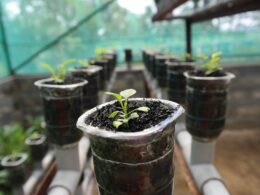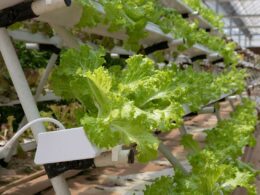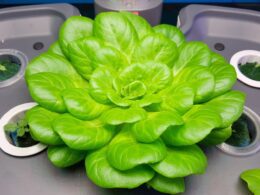Are you interested in growing your own plants but don’t have access to a traditional garden space? Hydroponics may be the solution for you.
Hydroponics is a method of growing plants without soil, using nutrient-rich water instead. It’s a popular option for those who want to grow their own produce in a small space, and it’s a great way to experiment with different plant varieties.
Before you dive into the world of hydroponics, it’s important to understand the basics. There are several different types of hydroponic systems available, each with its own advantages and disadvantages.
In this article, we’ll explore some of the most popular hydroponic systems for beginners, including deep water culture, drip irrigation, and nutrient film technique. We’ll also discuss how to choose the right system for your needs, so you can get started growing your own hydroponic garden with confidence.
Understanding the Basics of Hydroponics
You’re in the right place to grasp the fundamentals of nurturing plants without soil. Hydroponics is a method of growing plants in a nutrient-rich water solution, without the need for soil. Hydroponic benefits include faster growth, higher yields, and the ability to grow plants year-round. With this method, you’re able to control the environment and provide the plants with the exact nutrients they need for optimal growth.
One of the best things about hydroponics is that you can create your own DIY hydroponic setups. This means you don’t have to spend a lot of money to get started. Many of the materials you need can be found around the house or at a hardware store. You can also use a variety of containers, from plastic buckets to PVC pipes, to create your own hydroponic system.
By understanding the basics of hydroponics, you can start your own system and enjoy the benefits of growing plants without soil. With a little research, you can create a custom hydroponic setup that’s perfect for your needs.
Whether you’re growing herbs, vegetables, or flowers, hydroponics is a great way to get started with indoor gardening.
Deep Water Culture
In Deep Water Culture, plants are suspended in nutrient-rich water, with long white roots dangling and thriving in the oxygenated liquid. It’s a great choice for beginners who want an easy and affordable DIY setup.
All you need is a container, an air stone, and a pump. Fill the container with water and nutrients, insert the air stone and pump, and you’re ready to go.
But don’t forget about maintenance! To keep your Deep Water Culture system running smoothly, you’ll need to check the pH and nutrient levels regularly. You may also need to clean the container and replace the water every few weeks.
It’s important to keep an eye on the roots too, as they can easily become tangled and clogged in the system. By taking good care of your plants and system, you’ll ensure a healthy and bountiful harvest.
So if you’re looking for a beginner-friendly hydroponic grow system, Deep Water Culture is a great choice. With a simple DIY setup and some basic maintenance tips, you’ll be able to grow delicious and healthy plants in no time. So get started today and enjoy the benefits of hydroponics!
Drip Irrigation
Get ready to maximize your plant’s potential with the efficient and easy-to-use drip irrigation method! This hydroponic grow system involves a network of tubes that deliver a steady supply of nutrient-rich water directly to your plants’ roots.
Instead of flooding the entire grow tray, drip irrigation allows you to control the watering frequency and amount for each plant, promoting healthier growth and reducing water waste.
One of the benefits of drip irrigation is the flexibility it provides for plant spacing. Unlike other hydroponic grow systems, where plants must be placed at a certain distance from each other, with drip irrigation, you can adjust the distance between plants and the number of tubes to accommodate your desired plant density. This feature is especially useful for beginners who want to experiment with different plant configurations and maximize their grow space.
To make the most of your drip irrigation system, it’s important to monitor the watering frequency based on your plants’ needs. While some plants may require more water than others, a general rule of thumb is to water your plants for a few minutes at a time, a few times a day. This method ensures that your plants receive a steady supply of nutrients and water, without the risk of overwatering.
With drip irrigation, you can take the guesswork out of watering and focus on the fun part of hydroponic gardening – watching your plants thrive!
Nutrient Film Technique
Are you interested in learning about the Nutrient Film Technique? This hydroponic system uses a shallow stream of nutrient solution to constantly flow over the roots of plants.
While it’s a popular choice among growers, there are also some drawbacks to consider. For example, there’s the potential for clogs and the need for constant monitoring.
If you’re thinking about using this system, you’ll also want to know which plants work best with the Nutrient Film Technique.
How the System Works
You’ll be amazed at how your plants grow without soil, as the water and nutrients flow through their roots in a closed-loop system.
In the Nutrient Film Technique (NFT) system, a thin film of nutrient-rich water flows continuously over the roots of the plants, providing them with the necessary nutrients and oxygen they need to grow. The roots grow in a trough or channel, and the nutrient solution is pumped into one end of the channel and then flows down the length of the trough, before being collected at the other end and returned to the nutrient reservoir.
One of the advantages of the NFT system is that it uses less water than traditional soil-based agriculture, making it an ideal choice for areas with water scarcity. However, one of the disadvantages of this system is that if the nutrient solution flow is interrupted, the plants can quickly suffer and die.
It’s important to monitor the system regularly and make sure everything is flowing smoothly to ensure the health of your plants.
Pros and Cons of Using Nutrient Film Technique
If you’re looking for a sustainable and efficient way to cultivate your plants, nutrient film technique (NFT) might be the perfect fit for you. NFT is a hydroponic grow system that involves a continuous flow of nutrient solution over the roots of your plants, providing them with the necessary nutrients and water to grow.
One of the main advantages of NFT is that it requires less water and nutrients than other hydroponic systems, making it a cost-effective option for beginners. Additionally, NFT allows for more oxygen to reach the roots of your plants, promoting healthy growth and preventing root rot.
However, before you choose NFT as your hydroponic grow system, be aware of its potential drawbacks. Nutrient solution management can be tricky, as the flow of nutrient solution needs to be monitored constantly to prevent the roots from drying out or becoming waterlogged. Troubleshooting tips for NFT include checking the pH and nutrient levels of the solution and adjusting accordingly.
Overall, while NFT can be a great option for beginners, it requires careful management of the nutrient solution flow. Therefore, it’s important to have a solid understanding of hydroponic growing before diving in.
Best Plants for Nutrient Film Technique
Discover the best plants to grow in Nutrient Film Technique! Some of the top options include leafy greens like lettuce, spinach, and kale, as well as herbs such as basil and parsley. These plants are great for beginners since they’re relatively easy to grow and can be harvested quickly.
To successfully grow plants in NFT, make sure to maintain the appropriate pH level for each specific plant, check and adjust the nutrient solution regularly, and keep the roots from drying out. Avoid common mistakes like overcrowding the plants, neglecting the nutrient solution, and not providing enough light for growth.
By following these tips, you can grow a variety of plants in your NFT hydroponic system!
Choosing the Right Hydroponic System for You
Finding the perfect setup for your needs can be a bit overwhelming at first, but don’t worry – we’ve got you covered.
When it comes to choosing the right hydroponic system, there are a few factors to consider. Here are some things to keep in mind:
-
Budget options: If you’re just starting out, you may not want to invest a lot of money into a hydroponic system. Luckily, there are plenty of budget-friendly options available. Look for systems like Deep Water Culture or Kratky method, which require minimal equipment and maintenance.
-
Scalability: As you gain more experience and want to expand your hydroponic garden, it’s important to choose a system that can grow with you. Systems like Nutrient Film Technique and Aeroponics are great for scaling up, as they allow for multiple plants to be grown in one system.
-
Space: Consider the amount of space you have available for your hydroponic system. If you have limited space, a vertical system like a Tower Garden may be a good option. If you have more space, a larger system like a Dutch Bucket system may work better for you.
When it comes to choosing the right hydroponic system, it’s important to consider your individual needs and preferences. By keeping factors like budget, scalability, and space in mind, you can find a system that works best for you.
Remember, the most important thing is to have fun and enjoy the process of growing your own fresh produce!
Frequently Asked Questions
What is the minimum amount of space required to set up a hydroponic system?
Looking for small space solutions to set up your hydroponics system? Vertical gardening is the answer!
With this technique, you can grow plants vertically, saving you valuable floor space. You can set up a vertical hydroponic system on a balcony, in a small room, or even a closet.
The key is to choose plants that don’t require too much space to grow. You can start with herbs like basil, parsley, and thyme, or leafy greens like lettuce and spinach.
With the right setup, you can harvest fresh produce in your own home, even in a small space. Vertical gardening is a great way to get started with hydroponics and grow your own food.
Can hydroponic systems be used to grow plants that require a lot of sunlight?
If you’re looking to grow tomatoes hydroponically, you might be wondering if it’s possible to use a hydroponic system to grow plants that require a lot of sunlight. The answer is yes!
In fact, hydroponic systems can be a great choice for plants that love sunlight because they allow you to control the amount of light your plants receive. This means you can give your plants as much sunlight as they need without worrying about the weather or the time of year.
Plus, using a hydroponic system has many benefits, such as saving space, using less water, and avoiding soil-borne diseases. So if you’re thinking about growing sunlight-loving plants like tomatoes, consider using a hydroponic system to get the most out of your efforts.
How often do nutrient solutions need to be replaced in a hydroponic system?
To ensure optimal plant growth in hydroponic systems, it’s important to manage nutrient solutions properly. This includes monitoring the pH levels and nutrient concentrations regularly, and changing the solution as needed.
The frequency of nutrient solution replacement will depend on the type of plants being grown and the size of the system. Generally, smaller systems may require more frequent replacements, while larger systems may be able to go longer between changes.
As a rule of thumb, nutrient solutions should be replaced every two to three weeks to prevent nutrient imbalances and ensure healthy plant growth. Proper nutrient management is key to successful hydroponic gardening, so be sure to stay on top of your system’s needs.
Are there any plants that cannot be grown using hydroponic systems?
When it comes to hydroponic gardening, you may be wondering if there are any plants that cannot be grown using this method. While the answer is not a simple yes or no, there are certainly some challenges associated with growing certain plants hydroponically.
For example, root vegetables can be difficult to grow in hydroponics due to their need for ample space to develop. Additionally, nutrient deficiencies can be more common in hydroponics, making it important to closely monitor the nutrient levels of your system.
Despite these challenges, many plants can be successfully grown in hydroponics, and with careful planning and attention to detail, you can enjoy a bountiful harvest.
What are some common mistakes that beginners make when setting up a hydroponic system?
When setting up your hydroponic system, it’s important to avoid common mistakes that can hinder your plants’ growth.
One of the most common mistakes beginners make is not properly balancing the nutrients in their solution, which can lead to nutrient deficiencies or toxicities.
Another mistake is not properly monitoring pH levels, which can also affect nutrient absorption. To troubleshoot these issues, make sure to regularly test your solution and adjust nutrient and pH levels as needed.
It’s also important to properly sterilize your equipment and monitor for pests and diseases.
By taking these steps, you can ensure a successful hydroponic setup and healthy plants.
Conclusion
Congratulations on learning about hydroponics grow systems for beginners! With the basics of hydroponics understood, you can now choose the best hydroponic system for your needs.
Deep Water Culture is great for those who have limited space and time, while Drip Irrigation is perfect for those who want to conserve water and nutrients. Nutrient Film Technique is ideal for those who want a low-maintenance system that produces great results.
Remember, when choosing a hydroponic system, always consider your space, budget, and level of experience. With the right system in place, you can enjoy fresh and healthy produce all year round.
So go ahead and start your hydroponic journey today!









